PFAS Water Contamination Lawsuit
- Last Updated: July 14th, 2025

Attorney Jessica Paluch-Hoerman, founder of TruLaw, has over 28 years of experience as a personal injury and mass tort attorney, and previously worked as an international tax attorney at Deloitte. Jessie collaborates with attorneys nationwide — enabling her to share reliable, up-to-date legal information with our readers.
Legally Reviewed
This article has been written and reviewed for legal accuracy and clarity by the team of writers and legal experts at TruLaw and is as accurate as possible. This content should not be taken as legal advice from an attorney. If you would like to learn more about our owner and experienced injury lawyer, Jessie Paluch, you can do so here.
Fact-Checked
TruLaw does everything possible to make sure the information in this article is up to date and accurate. If you need specific legal advice about your case, contact us by using the chat on the bottom of this page. This article should not be taken as advice from an attorney.
Key takeaways:
- PFAS water contamination occurs through manufacturing discharges, firefighting foam use, landfill leaching, and wastewater treatment plants. 3M allegedly knew about and concealed the health and environmental dangers of PFAS as early as the 1970s.
- The number of PFAS water contamination lawsuits is rising as individuals, water providers, state attorneys general, and the federal government take legal action. Factors influencing settlement amounts include the extent of injuries, the strength of evidence, the number of defendants, and punitive damages.
- Governments are addressing the PFAS crisis through EPA's PFAS Action Plan, state drinking water standards, bans on PFAS products, and cleanup efforts. The EPA's designation of PFOA and PFOS as hazardous substances strengthens legal claims.
Overview of the PFAS Water Contamination Lawsuit
On this page, we’ll discuss an overview of the PFAS Water Contamination Lawsuit, potential settlement amounts in the PFAS Water Contamination Lawsuit, court rulings in PFAS Water Contamination Lawsuits, and much more.
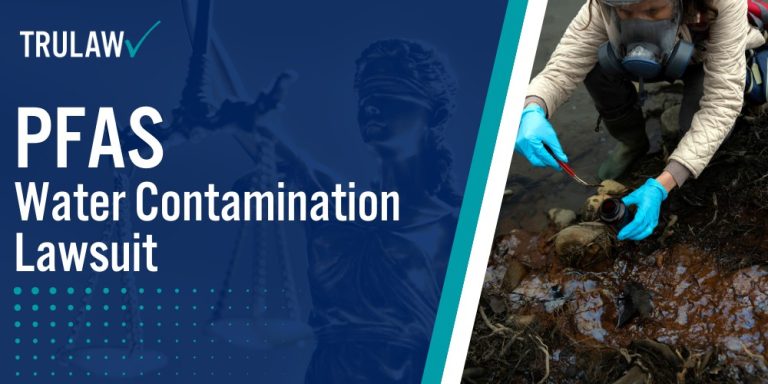
Intro to PFAS Water Contamination Lawsuit
Key aspects of the PFAS water contamination lawsuit include, but are not limited to:
- Health Effects: Exposure to PFAS in drinking water has been linked to various health problems, including cancer, immune system damage, and reproductive harm.
- Manufacturer Liability: The lawsuit alleges that major chemical companies like 3M and DuPont knew about the dangers of PFAS but failed to warn the public.
- Contamination Sources: PFAS can enter water supplies through industrial discharges, firefighting foam use, landfill leaching, and wastewater treatment plants.
- Legal Remedies: Individuals harmed by PFAS water contamination may be eligible for compensation through the ongoing multidistrict litigation.
If you or a loved one has developed cancer or other serious health conditions after exposure to PFAS-contaminated water, you may be eligible to file a PFAS water contamination lawsuit.
Contact Tru Law using the chat on this page for an instant case evaluation to determine if you qualify to join others filing in the PFAS water contamination lawsuit.
Table of Contents
How PFAS Contaminate Drinking Water Supplies
The PFAS water contamination lawsuit alleges that chemical manufacturers released these toxic substances into the environment for decades.
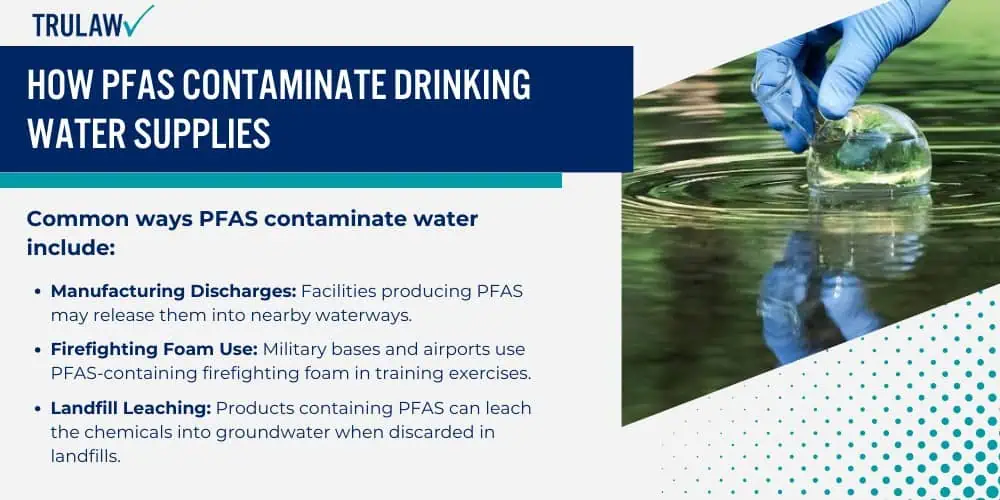
PFAS can enter groundwater and drinking water sources through industrial sites, airports, and military bases where PFAS chemicals are used heavily.
Common ways PFAS contaminate water include:
- Manufacturing Discharges: Facilities producing PFAS may release them into nearby waterways.
- Firefighting Foam Use: Military bases and airports use PFAS-containing firefighting foam in training exercises.
- Landfill Leaching: Products containing PFAS can leach the chemicals into groundwater when discarded in landfills.
- Wastewater Treatment Plants: PFAS can pass through treatment systems and contaminate water downstream.
Once PFAS enter the environment, they persist indefinitely, cycling through water, soil, and air.
This makes PFAS removal extremely difficult and costly to remediate, underscoring the importance of PFAS water contamination lawsuits holding polluters accountable.
3M’s Knowledge of PFAS Water Contamination Risks
The PFAS water contamination lawsuit accuses 3M of knowing about and concealing the health and environmental dangers of PFAS as early as the 1970s.
Internal company documents suggest that 3M was aware that PFAS could accumulate in humans and cause harm.
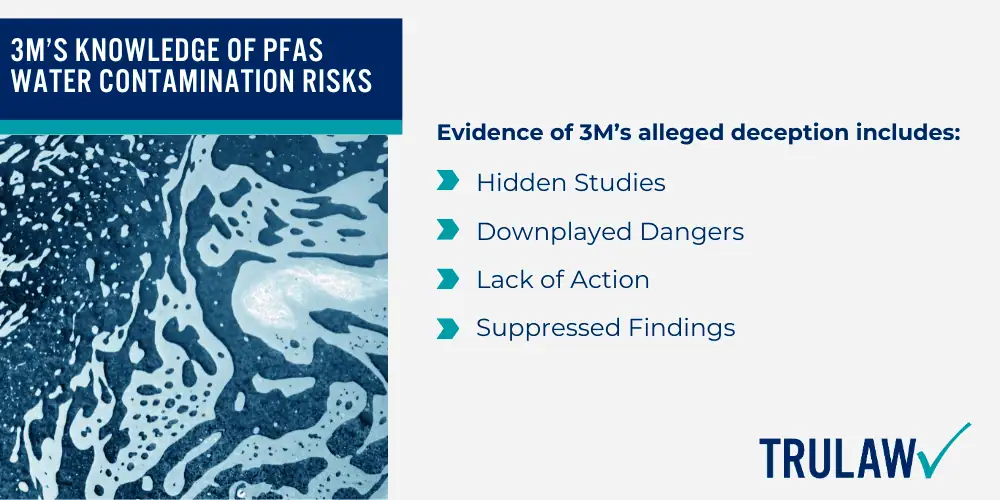
Evidence of 3M’s alleged deception includes:
- Hidden Studies: 3M research from the 1970s-80s found PFAS built up in human blood and animal organs.
- Downplayed Dangers: In 2000, 3M claimed no adverse health effects while sitting on evidence to the contrary.
- Lack of Action: 3M produced PFAS for decades without alerting the public or regulators to risks.
- Suppressed Findings: Former 3M scientists claim the company hid damning PFAS research to evade liability.
Individuals pursuing a PFAS water contamination lawsuit can point to 3M’s prior knowledge as proof the company acted negligently and put profits over people.
This strengthens the case for compensating victims.
Rise in PFAS Water Contamination Lawsuits Filed
As awareness of the PFAS water contamination crisis grows, so too does the number of PFAS water contamination lawsuits.
Individuals suffering from cancer and other health problems after exposure to PFAS-tainted water are taking legal action.
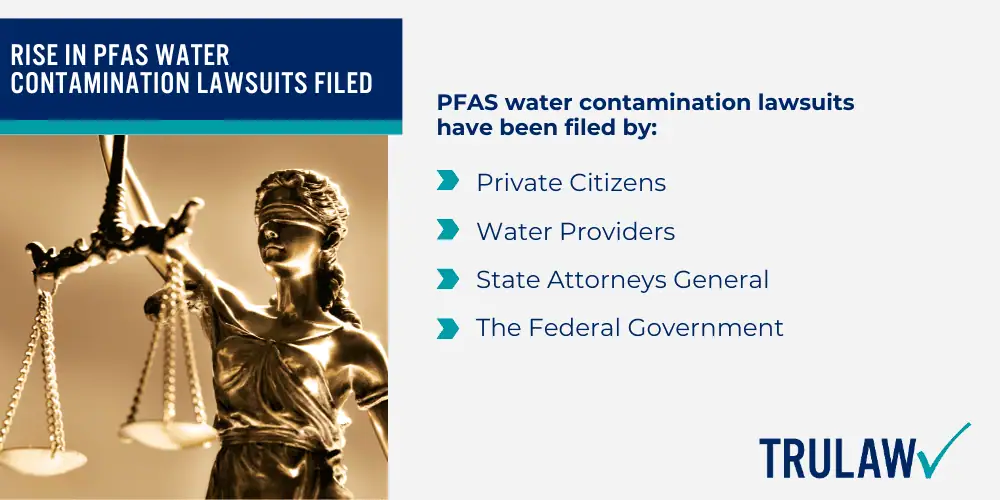
PFAS water contamination lawsuits have been filed by:
- Private Citizens: People who drank PFAS-contaminated water and developed serious illnesses.
- Water Providers: Cities and towns face huge costs to filter PFAS from public water systems.
- State Attorneys General: States like Ohio, New Hampshire, and Vermont are suing PFAS manufacturers.
- The Federal Government: The Department of Justice filed a PFAS water contamination lawsuit against 3M and DuPont.
If successful, these PFAS water contamination lawsuits could force companies to pay billions in cleanup costs and damages to affected individuals and communities.
Contact TruLaw today if you believe exposure to PFAS in your water made you sick.
Potential Settlement Amounts in the PFAS Water Contamination Lawsuit
The PFAS water contamination lawsuit aims to secure financial compensation for individuals harmed by exposure to these toxic chemicals.
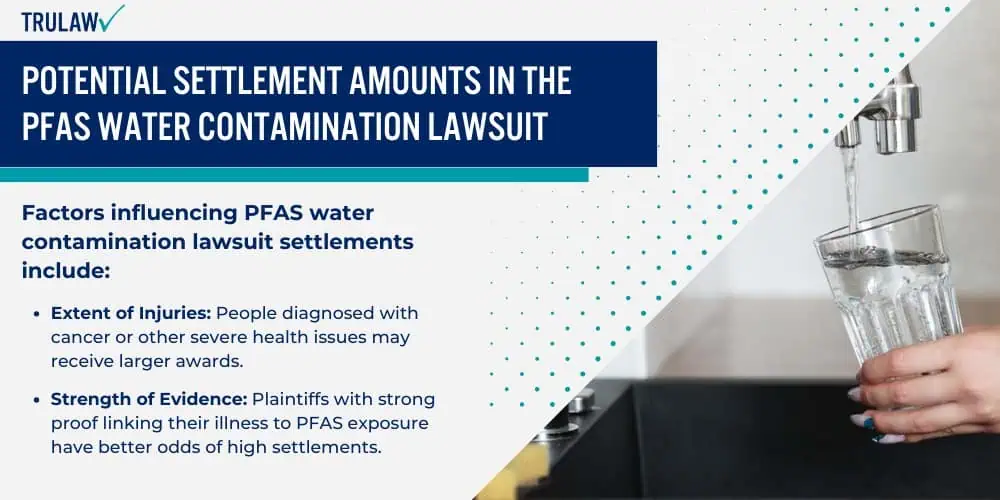
While settlement amounts will vary based on case specifics, some PFAS water contamination lawsuits have already resulted in significant payouts.
Factors influencing PFAS water contamination lawsuit settlements include:
- Extent of Injuries: People diagnosed with cancer or other severe health issues may receive larger awards.
- Strength of Evidence: Plaintiffs with strong proof linking their illness to PFAS exposure have better odds of high settlements.
- Number of Defendants: PFAS water contamination lawsuits naming multiple companies at fault can lead to bigger payouts.
- Punitive Damages: In cases of egregious corporate misconduct, juries may award additional money to punish defendants.
Estimating the settlement amounts of the average PFAS water contamination lawsuit is challenging as litigation is ongoing.
However, based on prior mass tort cases, top-tier claims could potentially fetch $150,000 to $375,000, with second-tier cases ranging from $75,000 to $180,000.
BASF Corp.’s $316.5M PFAS Water Contamination Lawsuit Settlement
BASF agreed to pay $316.5 million to resolve a PFAS water contamination lawsuit brought by public water systems in South Carolina.
The settlement will fund PFAS monitoring, treatment, and remediation in affected communities.
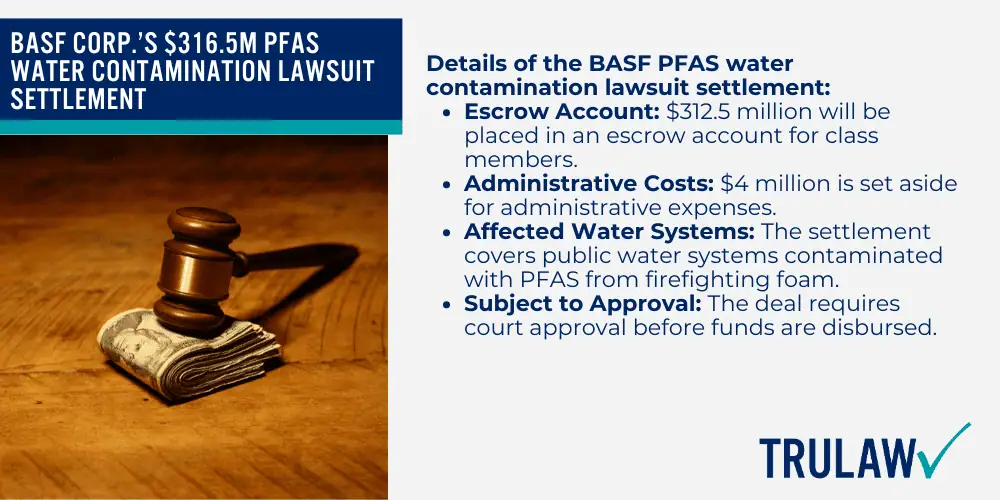
Details of the BASF PFAS water contamination lawsuit settlement:
- Escrow Account: $312.5 million will be placed in an escrow account for class members.
- Administrative Costs: $4 million is set aside for administrative expenses.
- Affected Water Systems: The settlement covers public water systems contaminated with PFAS from firefighting foam.
- Subject to Approval: The deal requires court approval before funds are disbursed.
This substantial PFAS water contamination lawsuit settlement demonstrates the potential for significant financial recovery in these cases.
It also underscores the importance of holding polluters like BASF accountable for PFAS contamination.
Tyco Fire Settles PFAS Water Contamination Claims
In April 2024, Tyco Fire joined other major PFAS manufacturers, such as 3M, Chemours, Corteva, and DuPont, in settling PFAS water contamination lawsuits.
Tyco agreed to pay $750 million to resolve claims its firefighting foam products contaminated water systems nationwide.
Key points in the Tyco PFAS water contamination lawsuit settlement:
- Remediation Efforts: Settlement funds will help affected cities and towns investigate and clean up PFAS contamination.
- Firefighting Foam Lawsuits: The settlement resolves claims related to Tyco’s manufacture and sale of PFAS-containing firefighting foam.
- Part of Broader Trend: Tyco’s settlement comes as other major PFAS producers move to resolve water contamination claims.
- Proactive Approach: By settling, Tyco aims to avoid prolonged legal battles and mounting liabilities.
The Tyco settlement is another win for plaintiffs in the PFAS water contamination lawsuit, showing the pressure on defendants to resolve these claims.
As more companies agree to pay up, it may encourage additional individuals impacted by PFAS to step forward.
Contact TruLaw: PFAS Chemical Exposure Attorneys
If you develop cancer or another serious health condition after exposure to PFAS-contaminated water, you may be eligible to file a PFAS water contamination lawsuit.
Contact TruLaw using the chat on this page to pursue the compensation you deserve.
Reasons to choose TruLaw for your PFAS water contamination lawsuit:
- Proven Track Record: We have a history of success in complex environmental litigation and mass tort claims.
- Deep Knowledge: Our team has extensively researched the PFAS water contamination crisis and relevant legal issues.
- Client Commitment: We provide personalized attention and keep you informed at every stage of your case.
- No Upfront Costs: You pay nothing unless we win a jury award or settlement in your PFAS water contamination lawsuit.
Don’t wait to hold PFAS polluters accountable for the harm they’ve caused.
Together, we’ll work to get you the justice you deserve.
PFAS Water Contamination Regulations and Actions
Governments and regulatory agencies are taking steps to address the growing PFAS water contamination crisis.
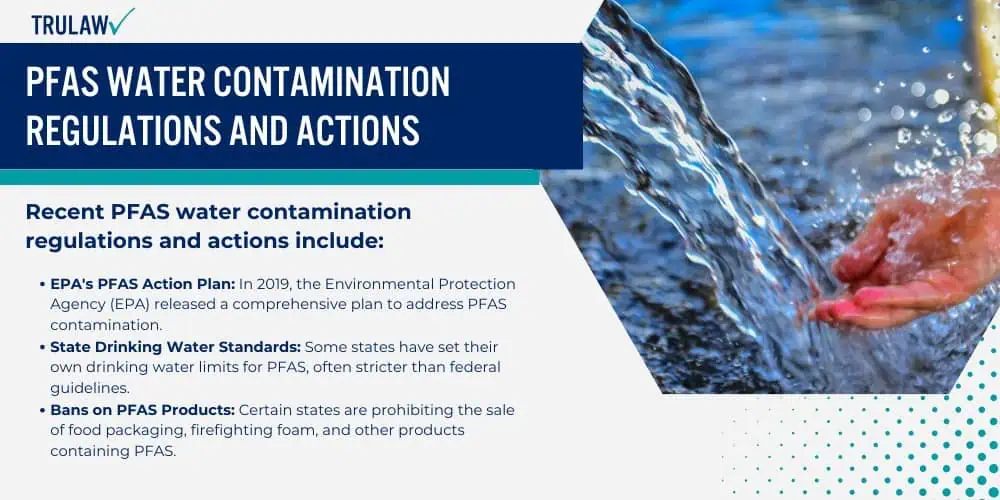
These actions aim to limit further PFAS releases, identify contaminated sites, and protect public health.
Recent PFAS water contamination regulations and actions include:
- EPA’s PFAS Action Plan: In 2019, the Environmental Protection Agency (EPA) released a comprehensive plan to address PFAS contamination.
- State Drinking Water Standards: Some states have set their own drinking water limits for PFAS, often stricter than federal guidelines.
- Bans on PFAS Products: Certain states are prohibiting the sale of food packaging, firefighting foam, and other products containing PFAS.
- Cleanup Efforts: The Department of Defense (DOD) and other agencies are working to clean up PFAS contamination at military bases and industrial sites.
As the scientific understanding of PFAS evolves, expect to see more regulations aimed at protecting communities from these harmful chemicals.
These actions may also support plaintiffs in PFAS water contamination lawsuits by establishing clear liability for polluters.
EPA’s New PFAS Water Contamination Hazard Designation
In April 2024, the EPA finalized a rule classifying two common PFAS, PFOA and PFOS, as hazardous substances under the Comprehensive Environmental Response, Compensation, and Liability Act (CERCLA).
This designation has significant implications for the PFAS water contamination lawsuit.
Impact of the EPA’s PFAS hazardous substance designation:
- Reporting Requirements: Facilities releasing PFOA or PFOS above certain levels must now report these incidents to the EPA.
- Increased Liability: The hazardous designation makes it easier to hold polluters liable for cleanup costs and damages.
- Superfund Implications: PFOA and PFOS-contaminated sites may now be eligible for cleanup under the EPA’s Superfund program.
- Potential Lawsuits: The rule may trigger a wave of new PFAS water contamination lawsuits against companies that released these chemicals.
By officially labeling PFOA and PFOS as hazardous, the EPA has taken a significant step in the fight against PFAS water contamination.
This action strengthens the legal claims of individuals harmed by these chemicals and pressures polluters to clean up their act.
States Enacting Laws to Monitor PFAS in Water
In response to growing concerns over PFAS water contamination, many states are passing laws to better monitor and regulate these chemicals in drinking water supplies.
These efforts help protect public health and support PFAS water contamination lawsuits by establishing clear safety standards.
Examples of state laws addressing PFAS water contamination:
- California’s AB 756: Requires public water systems to monitor for PFAS and report results to customers.
- Michigan’s PFAS Action Response Team: Created to investigate and respond to PFAS contamination statewide.
- New Jersey’s MCLs: Set maximum contaminant levels (MCLs) for PFOA, PFOS, and PFNA in drinking water.
- Washington’s PFAS Chemical Action Plan: Outlines strategies to reduce PFAS exposure, including water testing and cleanup.
As more states take action on PFAS water contamination, the federal government will be pressured to establish nationwide standards.
It also creates a patchwork of regulations that companies must navigate, increasing the likelihood of PFAS water contamination lawsuits for non-compliance.
New PFAS Water Contamination Lawsuits Filed
As awareness of the PFAS water contamination crisis spreads, more individuals are filing lawsuits against the companies responsible for releasing these toxic chemicals into the environment.
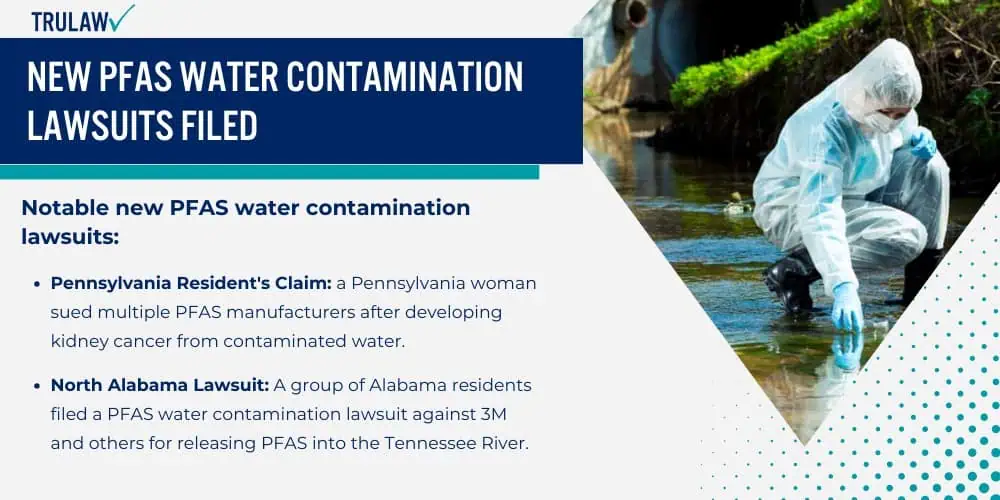
Recent PFAS water contamination lawsuits highlight the ongoing legal battle.
Notable new PFAS water contamination lawsuits:
- Pennsylvania Resident’s Claim: a Pennsylvania woman sued multiple PFAS manufacturers after developing kidney cancer from contaminated water.
- North Alabama Lawsuit: A group of Alabama residents filed a PFAS water contamination lawsuit against 3M and others for releasing PFAS into the Tennessee River.
- Kimberly-Clark Class Action: Connecticut residents are suing Kimberly-Clark for allegedly contaminating private wells with PFAS from its manufacturing plant.
- Village of Johnson City Lawsuit: The New York village is suing the U.S. Air Force for PFAS water contamination from a nearby base.
These PFAS water contamination lawsuits underscore the far-reaching impact of PFAS pollution and the determination of affected individuals to hold polluters accountable.
As more people come forward with their stories, expect to see a surge in PFAS water contamination litigation.
Pennsylvania Lawsuit Alleges Kidney Cancer from Water
In a recent PFAS water contamination lawsuit, a Philadelphia woman claims she developed kidney cancer after years of drinking water contaminated with PFAS.
She is suing a long list of chemical manufacturers for their alleged role in her illness.
Key details in the Pennsylvania PFAS water contamination lawsuit:
- Plaintiff’s Injuries: The woman was diagnosed with kidney cancer and had to undergo surgery to remove the affected organ.
- Contamination Allegations: The lawsuit claims the defendants’ PFAS chemicals contaminated the plaintiff’s drinking water, leading to her cancer.
- Failure to Warn: The complaint accuses the companies of failing to warn the public about the dangers of PFAS despite knowing the risks.
- Seeking Damages: The plaintiff is asking for compensatory and punitive damages related to her medical expenses, pain and suffering, and emotional distress.
This Pennsylvania PFAS water contamination lawsuit puts a human face on the crisis, showing the devastating impact PFAS can have on individuals and families.
It also demonstrates the importance of holding polluters liable for the harm they cause.
Class Action Over PFAS-Contaminated Drinking Wells
In March 2024, three Connecticut residents filed a class action PFAS water contamination lawsuit against Kimberly-Clark Corp., alleging the company’s manufacturing plant contaminated private drinking water wells with PFAS.
The case highlights the risk of PFAS pollution to those living near industrial facilities.
Allegations in the Kimberly-Clark PFAS water contamination lawsuit:
- Contamination Source: The plaintiffs claim PFAS from the Kimberly-Clark plant contaminated the air, soil, and groundwater near their homes.
- Property Damage: The lawsuit seeks damages for the loss of property value due to the PFAS contamination.
- Health Concerns: The complaint highlights the potential health risks posed by PFAS exposure, including cancer and other serious illnesses.
- Proposed Classes: The suit proposes two classes – one for property owners affected by the contamination and another for those who ingested the contaminated water.
This class action PFAS water contamination lawsuit against Kimberly-Clark shows how a single polluter can impact an entire community.
It also demonstrates the power of collective action in holding companies accountable for PFAS contamination.
Court Rulings in PFAS Water Contamination Lawsuits
As PFAS water contamination lawsuits make their way through the legal system, court rulings in these cases can significantly impact the trajectory of the litigation.
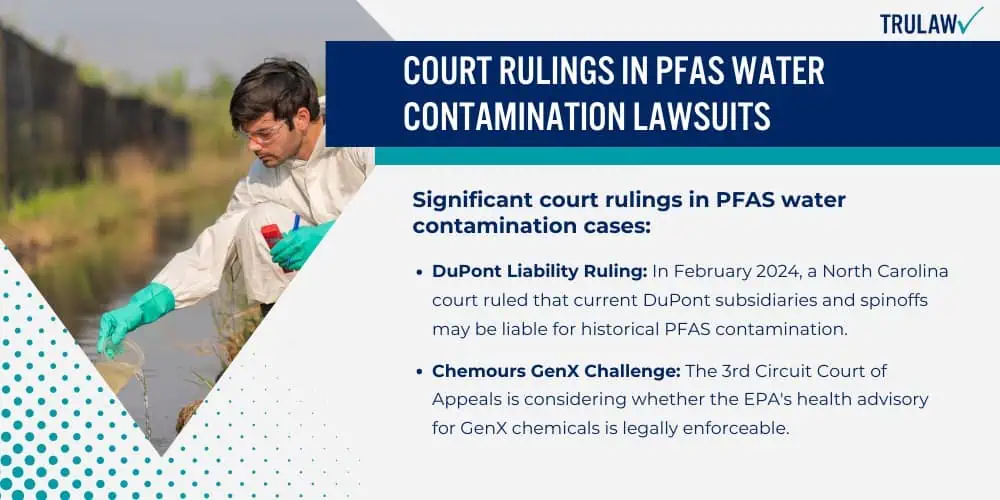
Recent decisions showcase the evolving legal landscape surrounding PFAS.
Significant court rulings in PFAS water contamination cases:
- DuPont Liability Ruling: In February 2024, a North Carolina court ruled that current DuPont subsidiaries and spinoffs may be liable for historical PFAS contamination.
- Chemours GenX Challenge: The 3rd Circuit Court of Appeals is considering whether the EPA’s health advisory for GenX chemicals is legally enforceable.
- Tyco Jurisdiction Decision: In April 2024, a federal court ruled that Vermont’s PFAS water contamination lawsuit against Tyco should proceed in state court.
- 3M Class Certification Overturned: The 6th Circuit Court of Appeals decertified a class of Ohio residents suing 3M over PFAS contamination, finding the plaintiffs lacked standing.
These court rulings demonstrate the sophisticated legal issues at play in PFAS water contamination lawsuits.
While some decisions favor plaintiffs, others create hurdles for those seeking justice.
Vermont Water Contamination Suit Against 3M Proceeds
In a win for plaintiffs, a federal court ruled in April 2024 that Vermont’s PFAS water contamination lawsuit against 3M should remain in state court.
The decision was a blow to 3M, which sought to move the case to federal jurisdiction.
Significance of the Vermont PFAS water contamination lawsuit ruling:
- State Court Jurisdiction: The ruling means Vermont can continue to pursue its claims against 3M in state court, which may be more favorable to the plaintiffs.
- Broad Contamination Claims: Vermont’s lawsuit alleges 3M’s PFAS products contaminated the state’s water, soil, and air, not just drinking water.
- Consumer Product Focus: The case highlights the role of consumer products like nonstick pans and stain-resistant fabrics in spreading PFAS contamination.
- Precedent for Other States: The decision may encourage other states to file similar PFAS water contamination lawsuits against polluters in their own courts.
By allowing Vermont’s PFAS water contamination lawsuit to proceed in state court, this ruling strikes a blow against 3M’s efforts to evade accountability.
It also underscores the importance of state-level action in addressing the PFAS crisis.
6th Circuit Dismisses Ohio Water Contamination Class
In a setback for plaintiffs, the 6th Circuit Court of Appeals dismissed a class action PFAS water contamination lawsuit brought by Ohio residents against 3M and other chemical manufacturers.
The court found the plaintiffs failed to establish standing to sue.
Key points in the 6th Circuit’s PFAS water contamination lawsuit ruling:
- Lack of Standing: The court ruled the lead plaintiff, Kevin Hardwick, lacked standing because he failed to show a concrete injury traceable to the defendants.
- Insufficient Allegations: The judges found Hardwick’s claims that PFAS were detected in his blood insufficient without proof of harm or identification of the specific manufacturer.
- Class Decertification: The decision overturns a lower court’s certification of a class of 11.8 million Ohio residents, effectively ending the class action.
- Impact on Future Cases: The ruling sets a high bar for establishing standing in PFAS water contamination lawsuits, which could deter some plaintiffs from filing claims.
While disappointing for the Ohio plaintiffs, the 6th Circuit’s decision is not necessarily fatal to all PFAS water contamination lawsuits.
Plaintiffs with stronger evidence linking their injuries to specific polluters may still have viable claims.
Health Effects Linked to PFAS in Drinking Water
The primary driver of PFAS water contamination lawsuits is the serious health risks associated with exposure to these chemicals.
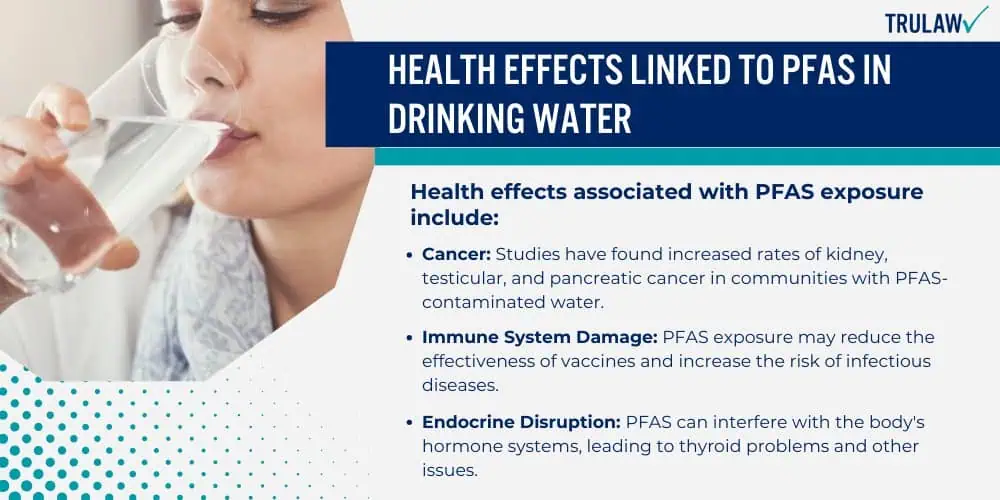
A growing body of scientific evidence links PFAS to a range of adverse health outcomes, from cancer to reproductive problems.
Health effects associated with PFAS exposure include:
- Cancer: Studies have found increased rates of kidney, testicular, and pancreatic cancer in communities with PFAS-contaminated water.
- Immune System Damage: PFAS exposure may reduce the effectiveness of vaccines and increase the risk of infectious diseases.
- Endocrine Disruption: PFAS can interfere with the body’s hormone systems, leading to thyroid problems and other issues.
- Reproductive Harm: Some studies suggest PFAS exposure may cause fertility issues and pregnancy complications.
As research into the health impacts of PFAS continues, even more adverse effects will likely be uncovered.
This underscores the urgency of addressing PFAS water contamination and holding polluters accountable through legal action.
Studies on Birth Defects from PFAS Water Contamination
Recent studies have raised concerns about the potential for PFAS water contamination to cause birth defects and developmental problems in children.
These findings add a new dimension to the PFAS water contamination lawsuit.
Research linking PFAS to birth defects:
- National Institutes of Health (NIH) Study: A 2022 NIH study found that exposure to PFAS during pregnancy may increase the risk of birth defects like cleft palate and hypospadias.
- Agency for Toxic Substances and Disease Registry (ATSDR) Report: The ATSDR has concluded that PFAS exposure may lead to decreased birth weight and developmental delays.
- C8 Health Project: A study of communities near a DuPont plant in West Virginia found a link between PFOA exposure and birth defects like neural tube defects and facial deformities.
- New York University (NYU) Research: A 2023 NYU study found that children exposed to PFAS in utero had a higher risk of being diagnosed with autism spectrum disorder.
These studies paint a troubling picture of the long-term consequences of PFAS water contamination for future generations.
They also provide compelling evidence for plaintiffs in PFAS water contamination lawsuits who have children with birth defects or developmental issues.
IARC: PFOA in Drinking Water Causes Human Cancer
In a major development for the PFAS water contamination lawsuit, the International Agency for Research on Cancer (IARC) declared in December 2023 that perfluorooctanoic acid (PFOA) is a known human carcinogen.
The announcement strengthens the legal claims of those suing over PFAS-related cancers.
Significance of the IARC’s PFOA cancer designation:
- Strong Evidence: The IARC based its decision on a comprehensive review of human and animal studies showing clear evidence of PFOA’s carcinogenicity.
- Specific Cancers: The agency found strong links between PFOA exposure and kidney cancer, as well as limited evidence for testicular and pancreatic cancer.
- Implications for Liability: The IARC’s designation makes it easier for plaintiffs to argue that PFOA exposure caused their cancer, bolstering their PFAS water contamination lawsuits.
- Pressure on Regulators: The announcement puts pressure on the EPA and other agencies to take stronger action on PFOA contamination in drinking water.
The IARC’s decision is a game-changer for the PFAS water contamination lawsuit, providing a clear scientific basis for holding PFOA manufacturers liable for cancer cases.
It also underscores the urgent need to address the public health crisis posed by PFAS contamination.
PFAS Water Contamination at Military Bases
Some of the most egregious examples of PFAS water contamination have occurred at U.S. military bases, where firefighting foams containing these chemicals were used for decades.
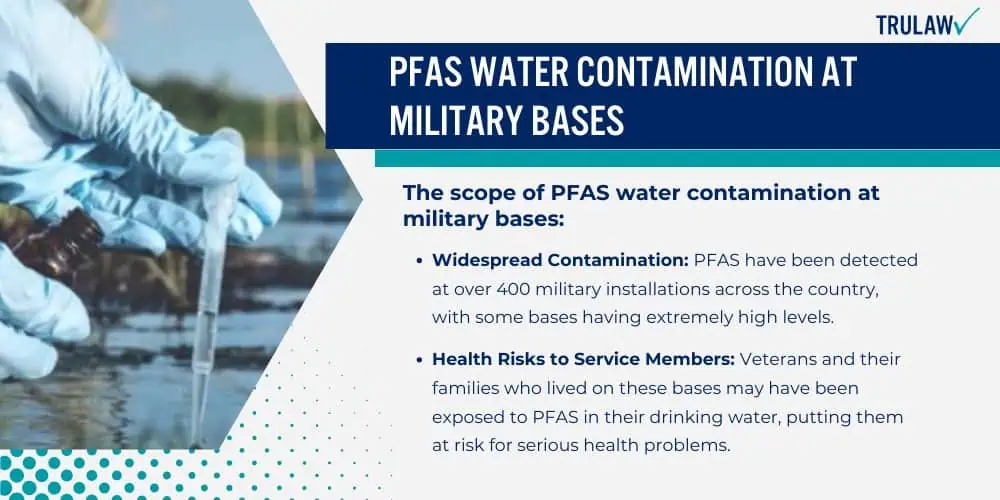
The Department of Defense (DOD) is now grappling with the fallout from this pollution.
The scope of PFAS water contamination at military bases:
- Widespread Contamination: PFAS have been detected at over 400 military installations across the country, with some bases having extremely high levels.
- Health Risks to Service Members: Veterans and their families who lived on these bases may have been exposed to PFAS in their drinking water, putting them at risk for serious health problems.
- Cleanup Challenges: The DOD estimates it will cost billions of dollars to clean up PFAS contamination at its facilities, a process that could take decades.
- Liability Concerns: The government faces a growing number of PFAS water contamination lawsuits from veterans and communities near military bases.
The PFAS water contamination crisis at military bases is a public health and environmental disaster that will have repercussions for years to come.
It also represents a major front in the legal battle over PFAS liability.
EPA Demands Navy Address PFAS in Hawaii Base Water
In March 2024, the EPA sent a stern letter to the U.S. Navy demanding action on PFAS water contamination at the Red Hill Bulk Fuel Storage Facility in Hawaii.
The move comes after years of concerns about the base’s impact on Oahu’s drinking water.
Key points in the EPA’s letter to the Navy:
- Contamination Levels: Testing has found PFAS levels in the groundwater near Red Hill far exceeding the EPA’s health advisory limits.
- Inadequate Response: The EPA criticized the Navy’s slow pace in investigating and addressing the PFAS contamination at the base.
- Required Actions: The letter demands that the Navy expand PFAS testing, evaluate cleanup options, and provide more transparency to the public.
- Threat to Drinking Water: The EPA warned that the PFAS contamination at Red Hill could threaten the drinking water supply for over 400,000 Oahu residents.
The EPA’s letter warns the Navy to take swift and comprehensive action to address the PFAS water contamination at Red Hill.
It also highlights the ongoing struggle to hold the military accountable for its role in the PFAS crisis.
DOD Report Reveals Widespread PFAS Water Contamination
A 2024 Department of Defense (DOD) report on PFAS water contamination at military bases paints a disturbing picture of the scope and severity of the problem.
The findings underscore the urgent need for action to address this environmental and public health crisis.
Key findings from the DOD’s PFAS water contamination report:
- Extensive Testing: The DOD tested drinking water at 400 installations across the country, finding PFAS at 250 of them.
- High Contamination Levels: Some bases had PFAS levels over 1 million parts per trillion (ppt), far exceeding the EPA’s 70 ppt health advisory.
- Affected States: The report identified bases with PFAS water contamination in 39 states, with Michigan, California, and Texas having the most.
- Firefighting Foam Use: The DOD confirmed that the primary source of PFAS contamination at its bases was the use of firefighting foam containing these chemicals.
The DOD’s report provides a comprehensive look at the staggering scale of PFAS water contamination at military bases nationwide.
It also underscores the need for urgent action to clean up this pollution and protect the health of service members and nearby communities.
List of Military Bases with PFAS in Drinking Water
The DOD’s report on PFAS water contamination at military bases identified several installations with alarmingly high levels of these chemicals in their drinking water.
Many of these bases are now subjects in the PFAS water contamination lawsuit.
Military bases with the highest PFAS drinking water contamination levels:
- England Air Force Base (Louisiana): 21 million ppt
- Naval Air Weapons Station China Lake (California): 8 million ppt
- Patrick Air Force Base (Florida): 4.3 million ppt
- Myrtle Beach Air Force Base (South Carolina): 2.64 million ppt
- Langley Air Force Base (Virginia): 2.2 million ppt
These shocking PFAS levels highlight the severity of the water contamination crisis at U.S. military bases.
They also provide strong evidence for plaintiffs in PFAS water contamination lawsuits against the government and foam manufacturers.
The DOD’s PFAS water contamination report is a wake-up call for urgent action to address this environmental and public health disaster.
It emphasizes the need for comprehensive testing, cleanup, and accountability at military bases across the country.
PFAS Contamination Lawsuit Frequently Asked Questions
-
PFAS chemicals can contaminate drinking water through manufacturing discharges, firefighting foam use, landfill leaching, and wastewater treatment plants.
Once PFAS enter the environment, they persist indefinitely and are difficult to remove from water.
-
Private citizens, water providers, state attorneys general, and the federal government are filing PFAS water contamination lawsuits.
These plaintiffs seek to hold PFAS manufacturers accountable for the harm caused by their products.
-
Recent PFAS water contamination regulations include the EPA’s PFAS Action Plan, state-level drinking water standards, and bans on PFAS-containing products.
Cleanup efforts are underway at military bases and industrial sites contaminated with PFAS.
-
PFAS chemicals are linked to serious health issues like thyroid disease, kidney and testicular cancer, and lower infant birth weights. These persistent chemicals contaminate drinking water and the environment, making them difficult to remove.
-
Per and polyfluoroalkyl substances (PFAS) are used in various industry and consumer products such as non-stick cookware, stain-resistant fabrics, and food packaging. Certain PFAS like hexafluoropropylene oxide dimer acid are particularly concerning due to their potential health risks.
-
To minimize PFAS exposure, individuals can avoid eating food from PFAS-containing packaging, use PFAS-free cookware, and filter their drinking water using activated carbon or reverse osmosis systems. Staying informed about PFAS strategic roadmap developments can also help reduce exposure risks.
-
Government agencies and organizations are working to measure PFAS levels in the environment, set regulatory limits, and develop technologies to remove PFAS from contaminated sites. The EPA’s PFAS Action Plan outlines a comprehensive approach to addressing this public health challenge.

Managing Attorney & Owner
With over 25 years of legal experience, Jessica Paluch-Hoerman is an Illinois lawyer, a CPA, and a mother of three. She spent the first decade of her career working as an international tax attorney at Deloitte.
In 2009, Jessie co-founded her own law firm with her husband – which has scaled to over 30 employees since its conception.
In 2016, Jessie founded TruLaw, which allows her to collaborate with attorneys and legal experts across the United States on a daily basis. This hypervaluable network of experts is what enables her to share the most reliable, accurate, and up-to-date legal information with our readers!
Additional PFAS Contamination Lawsuit resources on our website:
Here, at TruLaw, we’re committed to helping victims get the justice they deserve.
Alongside our partner law firms, we have successfully collected over $3 Billion in verdicts and settlements on behalf of injured individuals.
Would you like our help?
At TruLaw, we fiercely combat corporations that endanger individuals’ well-being. If you’ve suffered injuries and believe these well-funded entities should be held accountable, we’re here for you.
With TruLaw, you gain access to successful and seasoned lawyers who maximize your chances of success. Our lawyers invest in you—they do not receive a dime until your lawsuit reaches a successful resolution!
AFFF Lawsuit claims are being filed against manufacturers of aqueous film-forming foam (AFFF), commonly used in firefighting.
Claims allege that companies such as 3M, DuPont, and Tyco Fire Products failed to adequately warn users about the potential dangers of AFFF exposure — including increased risks of various cancers and diseases.
Depo Provera Lawsuit claims are being filed by individuals who allege they developed meningioma (a type of brain tumor) after receiving Depo-Provera birth control injections.
A 2024 study found that women using Depo-Provera for at least 1 year are five times more likely to develop meningioma brain tumors compared to those not using the drug.
Suboxone Tooth Decay Lawsuit claims are being filed against Indivior, the manufacturer of Suboxone, a medication used to treat opioid addiction.
Claims allege that Indivior failed to adequately warn users about the potential dangers of severe tooth decay and dental injuries associated with Suboxone’s sublingual film version.
Social Media Harm Lawsuits are being filed against social media companies for allegedly causing mental health issues in children and teens.
Claims allege that companies like Meta, Google, ByteDance, and Snap designed addictive platforms that led to anxiety, depression, and other mental health issues without adequately warning users or parents.
Transvaginal Mesh Lawsuits are being filed against manufacturers of transvaginal mesh products used to treat pelvic organ prolapse (POP) and stress urinary incontinence (SUI).
Claims allege that companies like Ethicon, C.R. Bard, and Boston Scientific failed to adequately warn about potential dangers — including erosion, pain, and infection.
Bair Hugger Warming Blanket Lawsuits involve claims against 3M — alleging their surgical warming blankets caused severe infections and complications (particularly in hip and knee replacement surgeries).
Plaintiffs claim 3M failed to warn about potential risks — despite knowing about increased risk of deep joint infections since 2011.
Baby Formula NEC Lawsuit claims are being filed against manufacturers of cow’s milk-based baby formula products.
Claims allege that companies like Abbott Laboratories (Similac) and Mead Johnson & Company (Enfamil) failed to warn about the increased risk of necrotizing enterocolitis (NEC) in premature infants.
Here, at TruLaw, we’re committed to helping victims get the justice they deserve.
Alongside our partner law firms, we have successfully collected over $3 Billion in verdicts and settlements on behalf of injured individuals.
Would you like our help?

